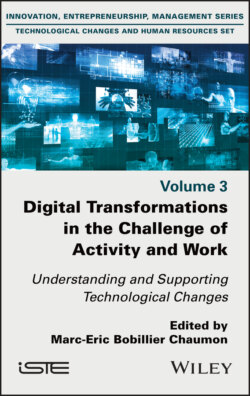Читать книгу Digital Transformations in the Challenge of Activity and Work - Группа авторов - Страница 19
1.3.4. Nomadism vs a sedentary lifestyle at work
ОглавлениеThe office is no longer the major or exclusive determinant of work. Thanks to digital environments (permanent office, “office in the pocket”), it has been exported, largely outside the walls of the company (work without borders) and has freed itself from the temporal, spatial and organizational barriers of the company. While some employees carry out an activity from their home (home office, teleworking; Vayre 2019), others tend to engage in a nomadic type of activity by alternating between workplaces (customer base, hotel, transport, third party places such as coworking areas, etc.) and different schedules (part of the work being carried out in “concealed” time, i.e. on transport or during other waiting times) (Vacherand-Revel 2017; Lutumba et al. 2020). These employees thus find themselves more or less voluntarily immersed in environments that each have their own requirements and that demand particular practices and uses. Thus, depending on the digital demands, employees must improvise their professional activities in situations that they do not always control, and which do not necessarily lend themselves to the task to be carried out with the technical system (Bonneau and Enel 2018). The different roles and work contexts then interpenetrate each other and this can create conflict (Marks and MacDermid 1996). Concretely, the individual may be psychologically and/or behaviorally engaged in one area/situation, but physically and temporally present in another area. Being able to carry out an activity in an inappropriate and potentially disruptive environment requires increased attention and focus (Popma 2013).
While nomadism is one of the characteristics of modern work, which technology has undoubtedly contributed to and has accentuated and accelerated it, sedentary life is paradoxically another facet of these digitized situations.
Indeed, there are still a number of economic sectors in which employees remain glued to their computers to carry out almost all the tasks inherent in their professional activity: from mediated interactions between colleagues (remote offices, being away from the workplace) to remote meetings, from information management (research, archiving) to training (e-learning) and even for moments of relaxation and social breaks (surfing on the web and social networks) (Debrosses 2019). It should be noted that this sedentary lifestyle has a major health cost since, according to epidemiological studies, it causes various major organic and physical disorders and causes mortality greater than that caused by cigarette consumption (Wen and Wu 2012). A study by the American Cancer Society indicated that the mortality rate of a person sitting more than six hours a day is 20% higher than that of a person sitting only three hours a day (Patel et al. 2010).
